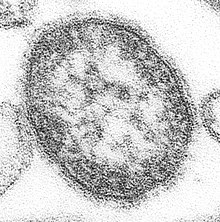Morbillivirus
| Morbillivirus | |
|---|---|

| |
electron micrograph
| |
| Virus classification | |
| (unranked): | Virus |
| Realm: | Riboviria |
| Kingdom: | Orthornavirae |
| Phylum: | Negarnaviricota
|
| Class: | Monjiviricetes |
| Order: | Mononegavirales |
| Family: | Paramyxoviridae |
| Subfamily: | Orthoparamyxovirinae |
| Genus: | Morbillivirus |
| Species | |
| |
Morbillivirus is a genus of
Genus
| Genus | Species | Virus (Abbreviation) |
| Morbillivirus | Morbillivirus canis
|
Canine distemper virus (CDV) |
| Morbillivirus caprinae | Peste-des-petits-ruminants virus (PPRV) | |
| Morbillivirus ceti | Cetacean morbillivirus (CeMV) | |
| Morbillivirus felis | Feline morbillivirus (FeMV) | |
Morbillivirus hominis
|
Measles virus (MeV) | |
| † Morbillivirus pecoris
|
Rinderpest virus (RPV) | |
Morbillivirus phocae
|
Phocine distemper virus (PDV) |
Structure

Morbillivirions are enveloped, with spherical geometries. Their diameter is around 150 nm. Genomes are linear, around 15–16 kb in length. The genome codes for eight proteins.[2][3]
| Genus | Structure | Symmetry | Capsid | Genomic arrangement | Genomic segmentation |
|---|---|---|---|---|---|
| Morbillivirus | Spherical | Enveloped | Linear | Monopartite |

Life cycle
Viral replication is cytoplasmic. Entry into the host cell is achieved by virus attaching to host cell. Replication follows the negative-stranded RNA virus replication model. Negative-stranded RNA virus transcription, using polymerase stuttering, through co-transcriptional RNA editing is the method of transcription. Translation takes place by leaky scanning. The virus exits the host cell by budding. Humans, cattle, dogs, cats, and cetaceans serve as the natural hosts. Infection from this virus takes place in five stages: incubation, prodromal, mucosal, diarrheic, and convalescent.[6][7] Transmission routes are respiratory.[2][3][8][9][10] Morbillivirus are sensitive to high temperatures, sunlight, extreme pH levels, and any chemical that can destroy its outer envelope.[11]
| Genus | Host details | Tissue tropism | Entry details | Release details | Replication site | Assembly site | Transmission |
|---|---|---|---|---|---|---|---|
| Morbillivirus | Humans, dogs, cats, cetaceans | None | Glycoprotein | Budding | Cytoplasm | Cytoplasm | Aerosols |
References
- PMID 31609197.
- ^ a b c "Family: Paramyxoviridae". International Committee on Taxonomy of Viruses (ICTV).
- ^ a b c "Morbillivirus". Viral Zone. ExPASy. taxid:11229. Retrieved 13 August 2015.
- ^ Jackson H (19 November 2014). "Virus causing Atlantic dolphin die-off". The Daily Times. p. T11. Retrieved 21 November 2022.
- PMID 37622664.
- S2CID 242980358, retrieved 7 January 2024
- PMID 37483821.
- PMID 8885706.
- PMID 25685949.
- ISBN 978-0-12-088385-1, retrieved 7 January 2024
- PMID 10582096
